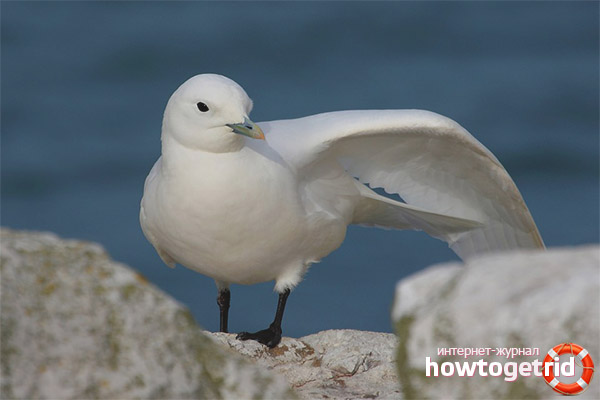The content of the article
The Latin name for the bird is a white gull - Pagophila eburnea. This species belongs to the gull family.
Description
This is a medium sized white bird. A little more than the gray representative of the family. Has a round head, legs and neck are short. The shape of the body makes it look a bit like a dove. Length - 40-47 cm, weight - about 450 g. It can reach up to 700 g. Wingspan - 105-120 cm.
Adult plumage acquires by the age of two. In any season, the plumage of the bird is white, with a touch of ivory. The bill is gray with a greenish or blue tint. The tip of the beak has a yellow or orange hue. Sometimes individuals with a completely yellow beak are found. Unlike other types of gulls, they have black paws.
The plumage of the nesting outfit is the same as the first winter one. Some parts of the body have blackish streaks. There are brown and black spots in front of the eyes and in the throat. The plumage underside of the wing is white.
White seagulls have a unique appearance, so they can not be confused with any other bird. Types of burgomaster, as well as polar gulls are much larger. Representatives of these species in the first year may also be almost white. But body proportions significantly distinguish them from white gulls. They have a larger beak, and their legs have a pinkish tint. The blue albino gull is also very similar in appearance to white. But they can be distinguished by a two-colored beak, as well as by the legs, which are white and short black gulls.
Vote
Usually silent. From time to time, it may make a crackling sound similar to the cry of a polar tern.
Habitat
Representatives of the species live near the North Pole. Their habitats depend on the state of the ice. When they do not nest, they can usually be in the area of drifting ice. In these places they seek food for themselves. In winter, these birds migrate south.
Lifestyle & Reproduction
These birds nest in colonies. To do this, they choose hard-to-reach spots. Nests are located on the islands, as far from the coast as possible. But there are cases when they equip a nest very close to people. Workers at polar stations claim that gulls sometimes nest right next to them. The success of breeding depends on the weather conditions in the area.
If during the summer the ice does not come off the surface of the reservoirs, then the white gull may not even start laying eggs. Scientists who watched them noticed that in this case, the birds just sit on the nest, as if hatching eggs. The decisive moment for them is the ability to get food during the nesting period. At the age of 2-3 years, individuals reach puberty. Young live constantly in the ice.
White seagull is the only species that remains in the ocean for a year.
They fly very fast, and can also run on the surface of the earth. White plumage makes them invisible against the background of snow and the northern sky. They feed on fish thrown ashore, because they do not know how to dive. Unpretentious to food. They can eat lemmings, invertebrates, and even chicks of other birds. In the summer they eat the waste of whaling. In winter, polar bears can follow to eat the remnants of their food. Sometimes after a storm on the shore there remains a huge number of cows, which birds feed on plenty.
During a severe snowstorm, they hide in shelter.Scientists suggest that for a while the seagulls can become numb, so they can survive without food.
Since the summer in these latitudes is extremely short, the breeding of birds occurs quickly. In July they lay 1-2 eggs. In August, chicks appear, which in a month can already fly.
These birds protect their nests from predator attacks. As soon as they see that the enemy is approaching, the birds attack him from all sides. They peck him and beat him with wings. The enemy has no choice but to leave the nesting place. And even after that, the seagulls chase him. When they are sure that they drove off the predator, they calm down and return to their nests.
To date, there has been a decrease in the number of these birds. This is due to climate change. In the Arctic, it is getting warmer, the area of glaciation is decreasing every year. This means that the birds have less space where they could nest. This is one of the reasons why representatives of the species are becoming less and less - they need protection.
Video: white gull (Pagophila eburnea)











Submit